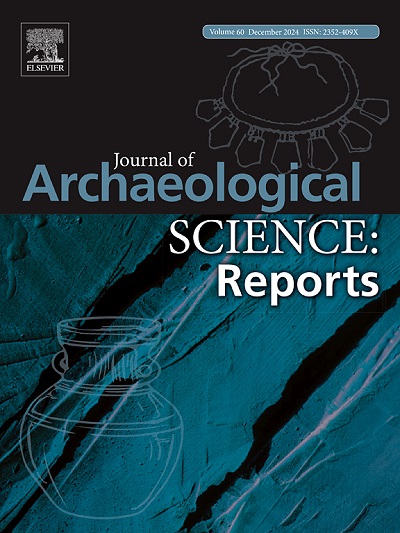迈锡尼色萨利的黄金加工:Volos湾四个tholos墓葬中金器的技术研究
IF 1.5
2区 历史学
0 ARCHAEOLOGY
引用次数: 0
摘要
在沃罗斯湾的背景下,迈锡尼人金矿的第一次全面分析研究是基于在迪米尼和沃罗斯出土的四个tholos古墓中超过165件黄金物品,包括完好的Kazanaki墓。使用XRF, PIXE,光学显微镜,扫描电镜和射线照相,这项工作调查了合金的组成和在色萨利这个重要地区使用的生产技术。结果表明,区域车间实践采用统一的生产工艺和一致的合金,人工生产可能使用冲积金。无磨损的标准金片陪葬饰品分批生产。这些有磨损迹象的物品是用同一种合金制成的,但使用了不同的技术,这表明金箔可能是由集中车间提供的。为了探索跨文化交流的潜在影响,我们与阿戈利德的物品进行了比较分析。在这项工作中分析的34个黄金项目和之前发表的研究数据显示,合金成分和生产工艺存在明显差异。在普罗西姆纳,一些修复过的红色调金珠可能反映了直接贸易或受外部(可能是埃及)审美和技术影响的地区适应。尽管迈锡尼和埃及作坊的黄金加工工艺有一些相似之处,但埃及的物品显示出独特的特征,例如可见的PGE夹杂物,硬焊接技术的使用以及更广泛的黄金色调,这些都突出了迈锡尼黄金加工传统的区域特殊性,特别是在沃罗斯湾。本文章由计算机程序翻译,如有差异,请以英文原文为准。
Goldworking in Mycenaean Thessaly: Technological study of the gold objects from the four tholos tombs in the Bay of Volos
A first comprehensive analytical study of Mycenaean goldworking in the context of the Bay of Volos is offered based on over 165 gold items from the four tholos tombs excavated at Dimini and Volos, including the tomb of Kazanaki found intact. Using XRF, PIXE, optical microscopy, SEM and radiography, this work investigates the composition of the alloys and the production techniques used in this significant region of Thessaly. The results indicate regional workshop practices, with uniform production techniques and consistent alloys, artificially produced likely using alluvial gold. The standardised gold sheet funerary ornaments showing no wear were produced in batches. The objects showing signs of wear were made with the same type of alloys but using different technologies, suggesting that the gold sheets may have been supplied by centralised workshops. To explore the potential influence of cross-cultural exchange, a comparative analysis with objects from the Argolid was conducted. The 34 gold items analysed in this work and data published in previous studies reveal distinct differences in alloy composition and production processes. At Prosymna, the reddish-toned gold beads, some repaired, may reflect either direct trade or regional adaptation influenced by external, perhaps Egyptian, aesthetic and skill. Despite some similarities in goldworking practices across Mycenaean and Egyptian workshops, Egyptian objects show unique features, such as the presence of visible PGE inclusions, the use of hard-soldering techniques and a broader range of gold hues, which highlight the regional specificity of Mycenaean goldworking traditions, particularly in the Bay of Volos.
求助全文
通过发布文献求助,成功后即可免费获取论文全文。
去求助
来源期刊

Journal of Archaeological Science-Reports
ARCHAEOLOGY-
CiteScore
3.10
自引率
12.50%
发文量
405
期刊介绍:
Journal of Archaeological Science: Reports is aimed at archaeologists and scientists engaged with the application of scientific techniques and methodologies to all areas of archaeology. The journal focuses on the results of the application of scientific methods to archaeological problems and debates. It will provide a forum for reviews and scientific debate of issues in scientific archaeology and their impact in the wider subject. Journal of Archaeological Science: Reports will publish papers of excellent archaeological science, with regional or wider interest. This will include case studies, reviews and short papers where an established scientific technique sheds light on archaeological questions and debates.
 求助内容:
求助内容: 应助结果提醒方式:
应助结果提醒方式:


